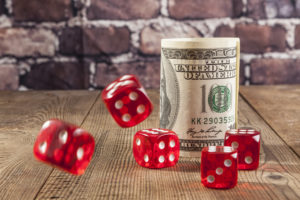A long, drawn out note to investors who may not have been sleeping so well lately…
Balancing Fear and Greed
When news broke Sunday night that the Saudi’s were essentially waging war on the global oil markets due to a disagreement between the Russians and OPEC, I knew that we’d be in for a very interesting trading day on Monday. When futures tripped a circuit breaker on Sunday night, I got to work, double and triple checking my watch list, making sure that I was confident in the fundamentals that back up my price targets, so that I would be able to make sound investing decisions when the market opened up on Monday morning.
Shortly after the opening bell on Monday, we tripped the -7% circuit breaker as well. This is a pretty rare occurrence. Flash crashes of the past came to mind. I remember all of the stocks that, with the benefit of hindsight, I wished I would have bought in 2018 when the short volatility trade imploded.
At the end of January, my portfolio’s cash position carried an ~9.5% weighting. This was fairly high for me, yet when I did my annual rebalancing at the end of 2019/beginning of 2020, I took measured steps to increase my cash position because I believed that the market was largely overpriced.
The vast majority of the high quality dividend growth stocks that I track on a regular basis appeared to be expensive back then and I decided that I didn’t mind holding an above average cash position, even though that cash didn’t do much to contribute to my passive income stream, because I knew that having more flexibility to take advantage of a potential sell-off would go a long way towards bolstering my dividend income stream over the long-run.
Towards the end of last year, I told subscribers that I thought the end of 2019 was shaping up in a similar fashion to the end of 2017. Back then, we saw an irrational run-up of share prices during December and January only to be followed by a sell-off early in the coming year. This year, the major difference was, crypto-currency wasn’t causing the market exuberance this time around. However, I still worried about the complacency that I saw income oriented investors showing as they flocked out of fixed into markets and into the equity space.
The animal spirits didn’t appear to be quite as vigorous during 2019, but at the end of the year, we saw 30%+ returns during a period of time where fundamentals didn’t really grow. In short, multiple expansion was the primary reason for much of the rally that we experienced during 2019 and this didn’t bode well for 2020 returns, in my opinion.
However, being that my passive income stream is my top priority, I haven’t been all that interested in trying to time the markets. Although I expressed valuation concerns, I also acknowledged that equities should trade at an abnormally high premium relative to historical averages because of the low interest rate environment that we’re investing in.
Furthermore, I also know well and good that markets can stay irrational for long periods of time and with that in mind, I wasn’t willing to sell stocks and hurt my dividend income stream because I continued to be cautiously optimistic on the equity markets in 2020 because at the end of the day, I know that much more often than not, U.S. markets grow, rather than shrink, on an annual basis.
Long-term readers of mine know that I come from the school of Warren Buffett and I think now is as good of a time as any to highlight the idea of American exceptionalism and the long-term wealth generating power of the U.S. stock markets.
I always come back to Buffett’s upward bias when thinking about asset allocation and my cash weighting. For awhile now, I’ve worried that the T.I.N.A. market was artificially inflating the fundamentals associated with high quality dividend stocks and while I didn’t have any idea when this bubble might pop, I wanted to make sure that I had dry powder to put to work when it did.
But, I also didn’t want to damage my income stream, which led to a balancing act that resulted in a roughly 10% target cash weighting.
I knew that the markets were down roughly 18% from all-time highs and thought to myself, “you hold cash to put to work during market sell-offs; if you’re not willing to be aggressive here, what’s the point of holding that cash?”
And so I did, picking up a handful of shares of high quality names that traded below my fair value estimates. What’s more, I didn’t experience a bit of buyer’s remorse because I knew that I was sticking to my plan with regard to a slow and steady approach in these volatile markets.
I recognize that while we’ve experienced a lot of negative volatility in recent days/weeks, the market (and more importantly, many of the individual stocks that it is comprised of) still appears to be expensive. I’m still 10-20% off of many of my price targets on the bluest chip stocks that I track. I want to makes sure that I have dry powder left to potentially buy those stocks at discounts if they arrive.
With that in mind, I knew that I would have to continue to average into the current sell-off slowly since I continued to prioritize the flexibility that came was an adequate cash position.
Taming The Black Swan
In no way did I foresee the Covid-19 issue or the more recent oil price wars. Yet, so far into a bull market run, I assumed that it was only a matter of time before the dreaded black swan appeared. No one ever knows anything about the when, how, why, where, or what of a black swan. That’s her very nature. But, they do bring down markets, especially complacent ones.
The market hates uncertainty and in general, human beings don’t react well to change. Fear is often the response to events like this and I certainly haven’t been surprised to see the selling during the last couple of weeks.
Honestly, I surprised to see how orderly the trading went during the rest of the day after the circuit breaker went off shortly after the opening bell on Monday. 1,000+ point swings have become the new normal in the market today and I somewhat expected to see us test the -13% breaker as well. I’ve been looking for capitulation in the markets and frankly, I don’t believe that I’ve seen that yet.
Selling was strong today, but to me, it appeared to be justified. The energy sector makes up a relatively small percentage of the S&P 500, but the games that the Saudis are playing with the oil markets will likely have a significant impact on Main Street in many U.S. communities. To me, the combination of Covid-19 and a slowdown in the oil patch has the potential to lead to a significant economic slowdown in the U.S. and abroad.
However, things are never that simple. I think there is an argument to be made that both of these headwinds are transient and don’t represent the systemic threat that we saw during the Great Recession. But, I do think there is potential for longer term damage to economic growth. I expect to see plenty of earnings misses and negative revisions in the coming quarters. In other words, I don’t think that we’ve reached a bottom yet.
But, I’m also not here to attempt to call a bottom. Doing so would be foolish. So, while I worry about the potential for further weakness, I’ve been happy to average down into the weakness.
I’ve put roughly 33% of the cash position that I came into the year with to work thus far. Right now, cash makes up roughly 7.5% of my portfolio, yet it’s important to note that this percentage is only so high because of the unrealized capital losses that I’ve seen across my holdings in recent weeks.
Overall, my portfolio is down 15.3% from the all-time high mark that it set on February 19th. I hate seeing these types of losses, but I also understand that paper losses aren’t real until I realize them with a sale. Back to Buffett and the value investing principles that I’ve gleaned from his words over the years, I knew that selling low is a bad long-term practice. With this nugget in mind, I’m content to ride out the storm.
For what it’s worth, my portfolio has drastically outperformed the S&P 500 (SPY) during this sell-off. The SPY is down 19.1% from its all-time highs. While beating the broader markets is one of my stated goals, what’s most important to me are my forward looking dividend projections for 2020.
Right now, my portfolio is expected to post double digit dividend growth relative to 2019’s full-year total. While there is no such thing as a sure thing with regard to equity dividends, I am highly confident in the dividend safety of my holdings and the likelihood for continued dividend growth in 2020, regardless of the macro economic environment, and with that in mind, I’m sleeping easy these days even though my net worth has decreased significantly.
Staying True To Yourself
I know it took me awhile to get here, but this is the point of this entire article: sleeping easy.
As I wrote this piece, it evolved from an introduction of a list of trades that I made on Monday into a more philosophical exposition on maintaining peace of mind during market weakness. I’m sorry for the roundabout delivery, but now that we’re here, I feel as if we’re arrived at the right destination.
I see fear in the markets. It’s clearly thriving in the comment threads associated with articles across the internet, on online forums and social media, and even in the chat room here at The Dividend Kings. I’m not surprised by this. Monday was one of the worst trading days in the stock market’s history. Because of this, I was happy to sort of take a detour and talk about peace of mind because fear and the irrationality that it inspires can cause investors to make mistakes that have long lasting implications on their financial futures.
I know readers are interested in my thoughts with regard to the market and the management decisions that I’m making with regard to my personal portfolio, but more than anything, I want to attempt to hammer home the idea that it is possible to sleep like a baby during “Black Monday” type events because of a reliably increasing income stream.
That’s why we’re all here, right? I imagine that not many of you would have joined a service titled, “The Dividend Kings” if you weren’t interested in dividends.
I don’t worry about short-term volatility in the markets because I have high conviction when it comes to the long-term bullish theses that I’ve based my investment decisions upon. Also, I know that short-term moves are oftentimes driven by speculation, which is the enemy of of value investing.
Nowadays, algorithms make most of the trades, pushing use a step further away from the rational human mind. Some say that this is better. That the human psyche can’t possibly compute all of the necessary variables in play at any given point or time that would be required to make the best decision. While that’s probably true, I think this line of thinking discounts the individual.
When it comes to making investment decisions, what’s right for me may not be right for you. Everyone has slightly different financial situations, goals, dreams, saving rates, time horizons, nest eggs, risk tolerances, and so on and so forth. I imagine it’s theoretically possible to program an algorithm to account for these things, but I can say, this certainty, that I’ve never been asked for input from the big boys who’re accounting for most of the trading volumes.
Having a good grasp on your personal goals, the strategy that you plan to adhere to in pursuit of them, and the more basic philosophies that this strategy is built upon, as well as the underlying fundamentals of the companies that you use as tools to achieve your goals along the way, can shield you from uncertainty and therefore, fear.
This requires hard work and preparation. It requires deep thought and contemplation. But, as I’ve said before, I think it’s possible for anyone with the proper passion to become a successful self directed investor.
Facts fight fear that is based upon unknown variables. Faith fights fear that spawns from doubts associated with questions that are unanswerable. As in all things in life, in the market, an investor will constantly have to deal with both. Yet, I can assure you, that is it possible to come across a black swan and still S.W.A.N. (sleep well at night) if you have confidence in the individualized path that you’ve chosen towards financial freedom.
With all of this in mind, I’ll close this piece by simply saying, don’t stray from the path. Don’t let change in the markets change you. Believe in the systems that have been successful for you in the past. Trust in the intuition that born by your experience. Ignore the noise and the naysayers and stay true to yourself because at the end of the day, achieving your goals is all that matters in the market.





